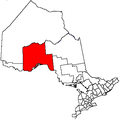Municipality in Ontario, Canada
| Neebing | |
|---|---|
| Municipality (single-tier) | |
| Municipality of Neebing | |
 Rural scene of Neebing with the Nor'Wester Mountains in the background Rural scene of Neebing with the Nor'Wester Mountains in the background | |
 | |
| Coordinates: 48°11′N 89°28′W / 48.183°N 89.467°W / 48.183; -89.467 | |
| Country | |
| Province | Ontario |
| District | Thunder Bay |
| Incorporated | 1881 |
| Government | |
| • Mayor | Mark Thibert |
| • Federal riding | Thunder Bay—Rainy River |
| • Prov. riding | Thunder Bay—Atikokan |
| Area | |
| • Land | 877.27 km (338.72 sq mi) |
| Population | |
| • Total | 2,055 |
| • Density | 2.3/km (6/sq mi) |
| Time zone | UTC-5 (EST) |
| • Summer (DST) | UTC-4 (EDT) |
| Forward sortation area | P7L |
| Area code | 807 |
| Website | http://www.neebing.org |
Neebing is a municipality in the Canadian province of Ontario, located in the Thunder Bay District immediately south of the city of Thunder Bay. It is part of Thunder Bay's Census Metropolitan Area.
History
Neebing comprises the former geographic townships of Blake, Crooks, Pardee, Pearson and Scoble. It was incorporated in its current form on January 1, 1999. It should not be confused with the geographic township of Neebing, which was amalgamated into the City of Thunder Bay in 1970.
The Municipality of Neebing was incorporated in 1881 by the Legislative Assembly of Ontario. It included Neebing township, Neebing Additional township, Blake, Crooks and Pardee townships. In 1892 all of Neebing Additional township and a large portion of Neebing township was removed to form the City of Fort William. In 1970 the remainder of Neebing township was also removed from the Municipality of Neebing, leaving it with only the name.
Geography
Communities
The municipality includes the communities of Cloud Bay, Jarvis River, Moose Hill, Scoble West and Wamsley.
Demographics
In the 2021 Census of Population conducted by Statistics Canada, Neebing had a population of 2,241 living in 942 of its 1,205 total private dwellings, a change of 9.1% from its 2016 population of 2,055. With a land area of 873.78 km (337.37 sq mi), it had a population density of 2.6/km (6.6/sq mi) in 2021.
Canada census – Neebing community profile| 2021 | 2016 | 2011 | |
|---|---|---|---|
| Population | 2,241 (+9.1% from 2016) | 2,055 (+3.5% from 2011) | 1,986 (-9.1% from 2006) |
| Land area | 873.78 km (337.37 sq mi) | 877.27 km (338.72 sq mi) | 877.60 km (338.84 sq mi) |
| Population density | 2.6/km (6.7/sq mi) | 2.3/km (6.0/sq mi) | 2.3/km (6.0/sq mi) |
| Median age | 48.8 (M: 48.8, F: 48.8) | 48.5 (M: 49.3, F: 47.4) | |
| Private dwellings | 940 (total) | 1,166 (total) | 1,096 (total) |
| Median household income | $87,424 |
| Year | Pop. | ±% |
|---|---|---|
| 1996 | 2,102 | — |
| 2001 | 2,049 | −2.5% |
| 2006 | 2,184 | +6.6% |
| 2011 | 1,986 | −9.1% |
| 2016 | 2,055 | +3.5% |
| 1996 figure after adjusting to 2001 boundaries | ||
See also
References
- ^ "Census Profile, 2016 Census: Neebing". Statistics Canada. 8 February 2017. Retrieved July 12, 2019.
- "Population and dwelling counts: Canada, provinces and territories, census divisions and census subdivisions (municipalities), Ontario". Statistics Canada. February 9, 2022. Retrieved March 31, 2022.
- "2021 Community Profiles". 2021 Canadian census. Statistics Canada. February 4, 2022. Retrieved 2022-04-27.
- "2016 Community Profiles". 2016 Canadian census. Statistics Canada. August 12, 2021. Retrieved 2019-07-12.
- ^ "2011 Community Profiles". 2011 Canadian census. Statistics Canada. March 21, 2019. Retrieved 2012-03-29.
- Statistics Canada: 1996, 2001, 2006, 2011 census
External links
| Places adjacent to Neebing | ||||||||||||||||
|---|---|---|---|---|---|---|---|---|---|---|---|---|---|---|---|---|
| ||||||||||||||||
